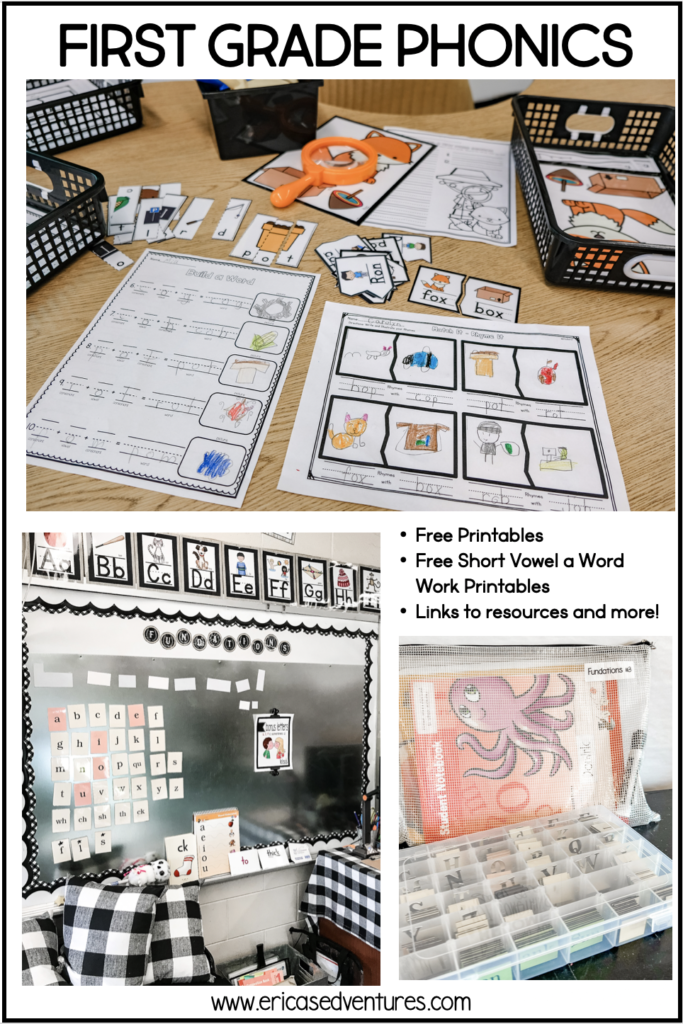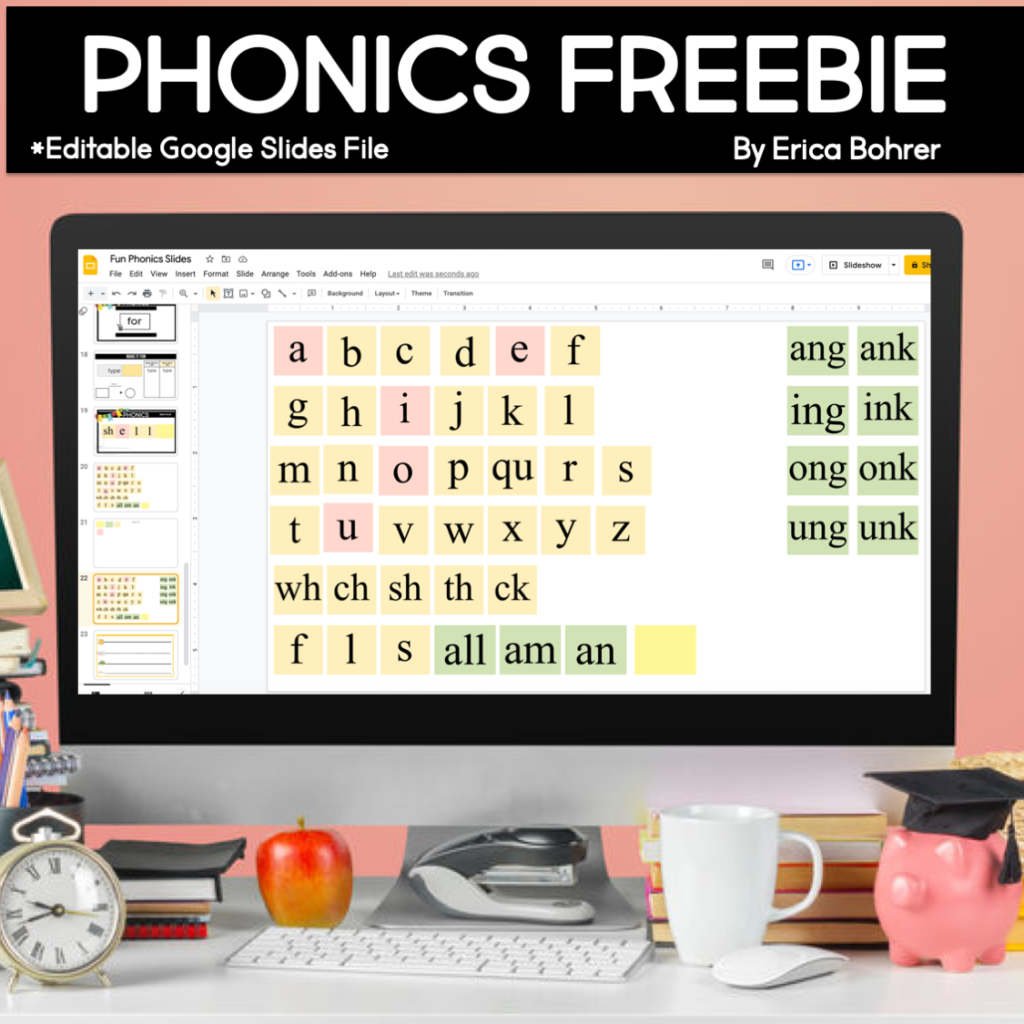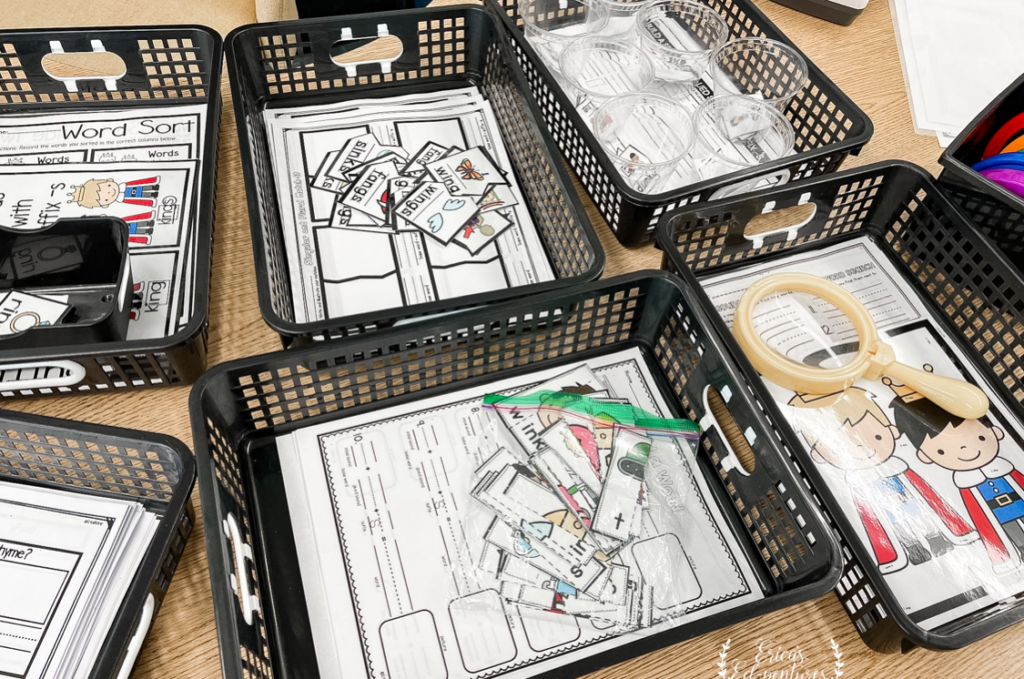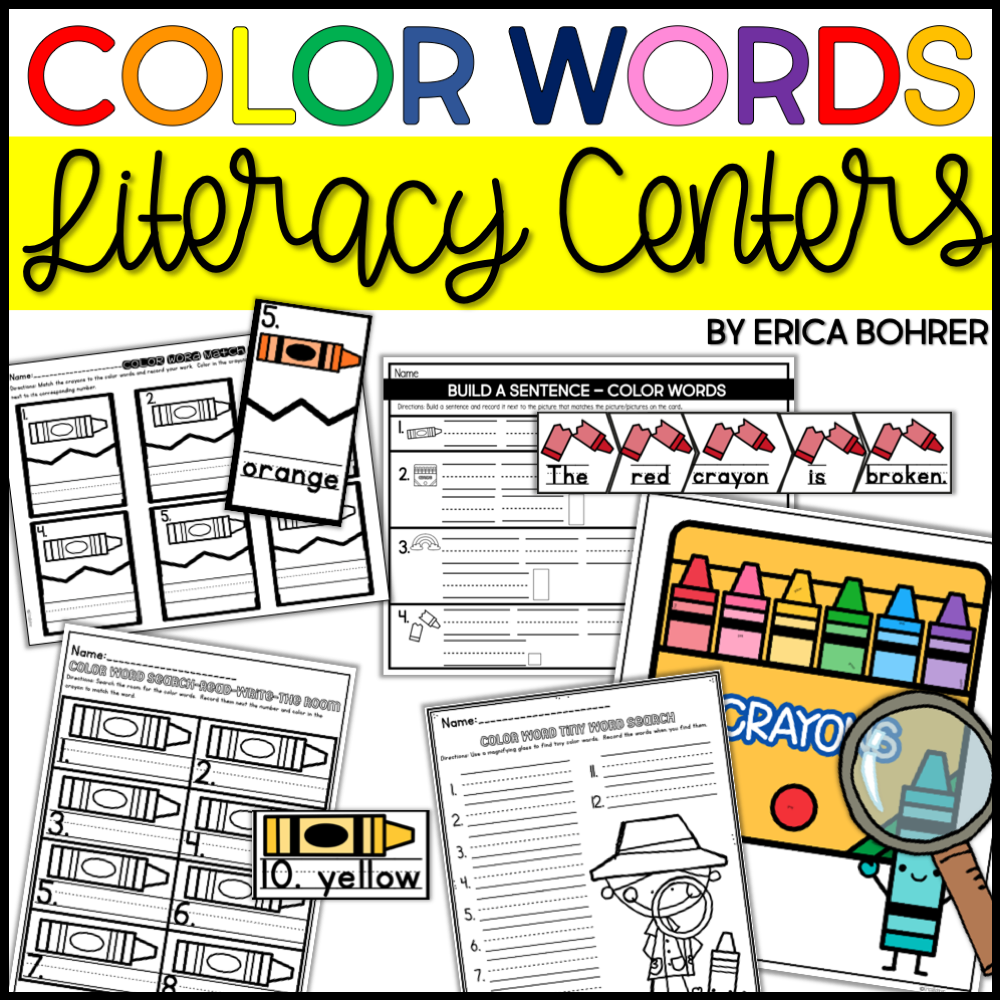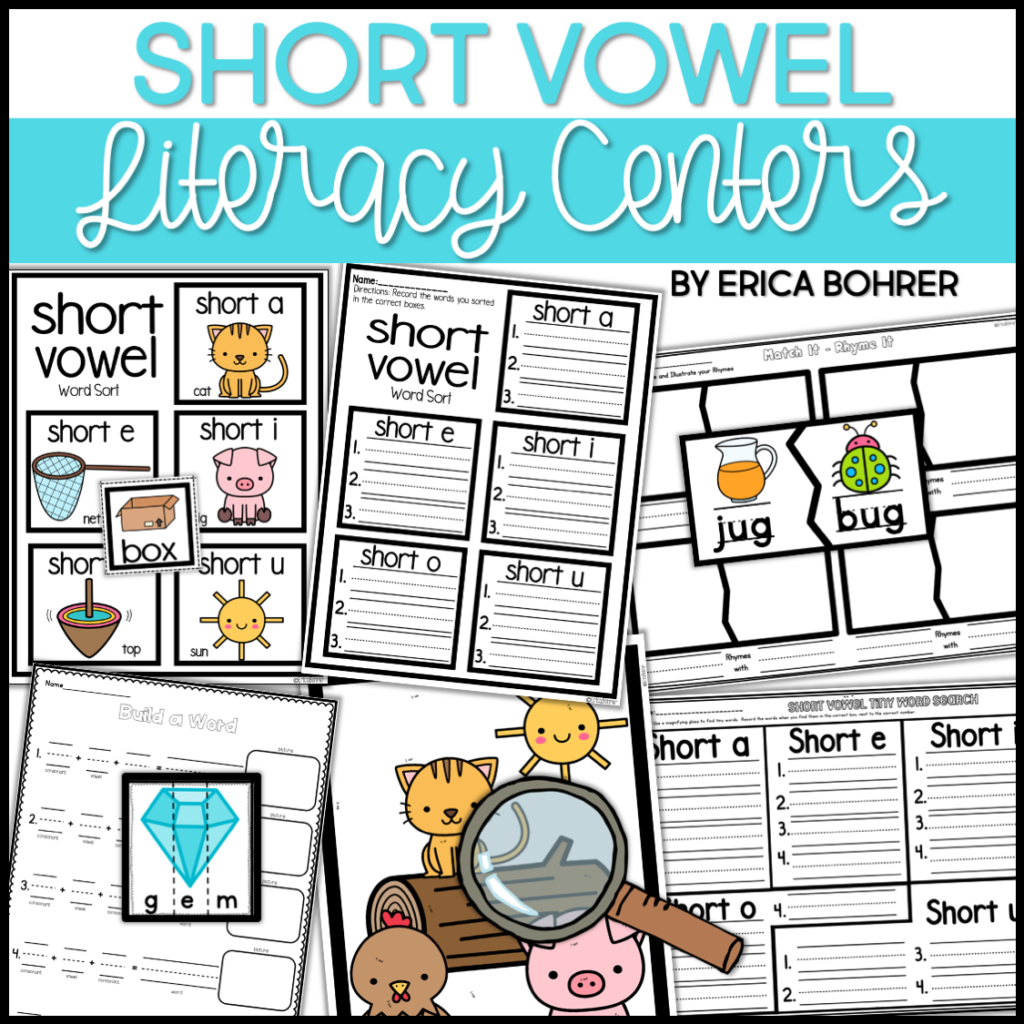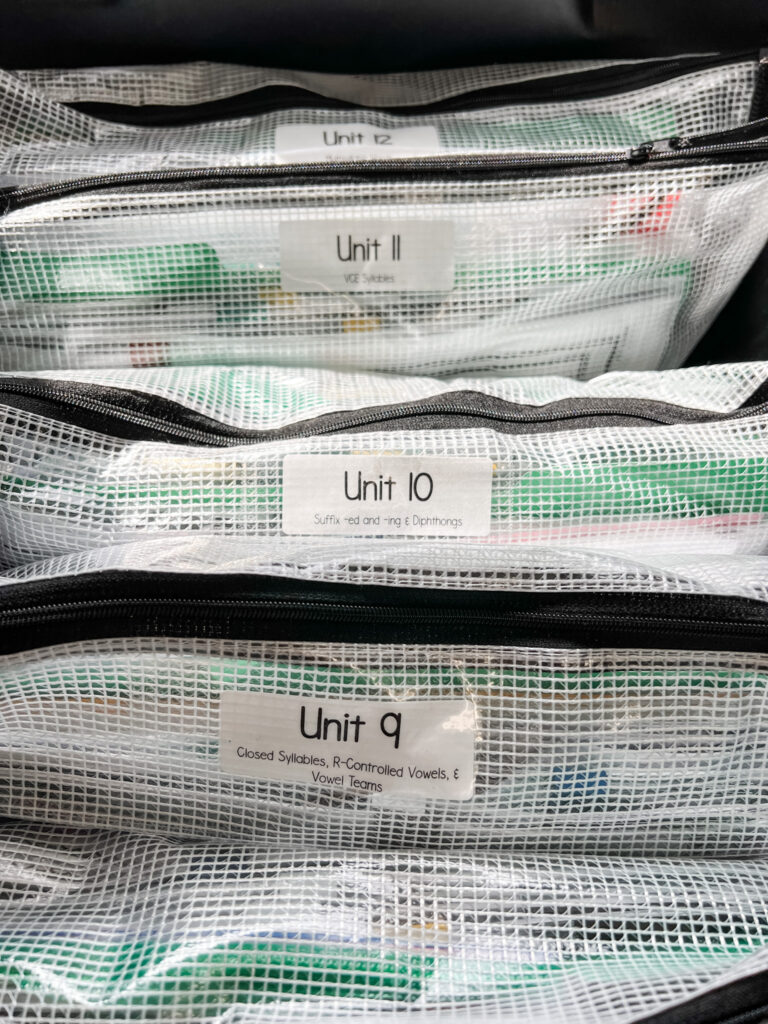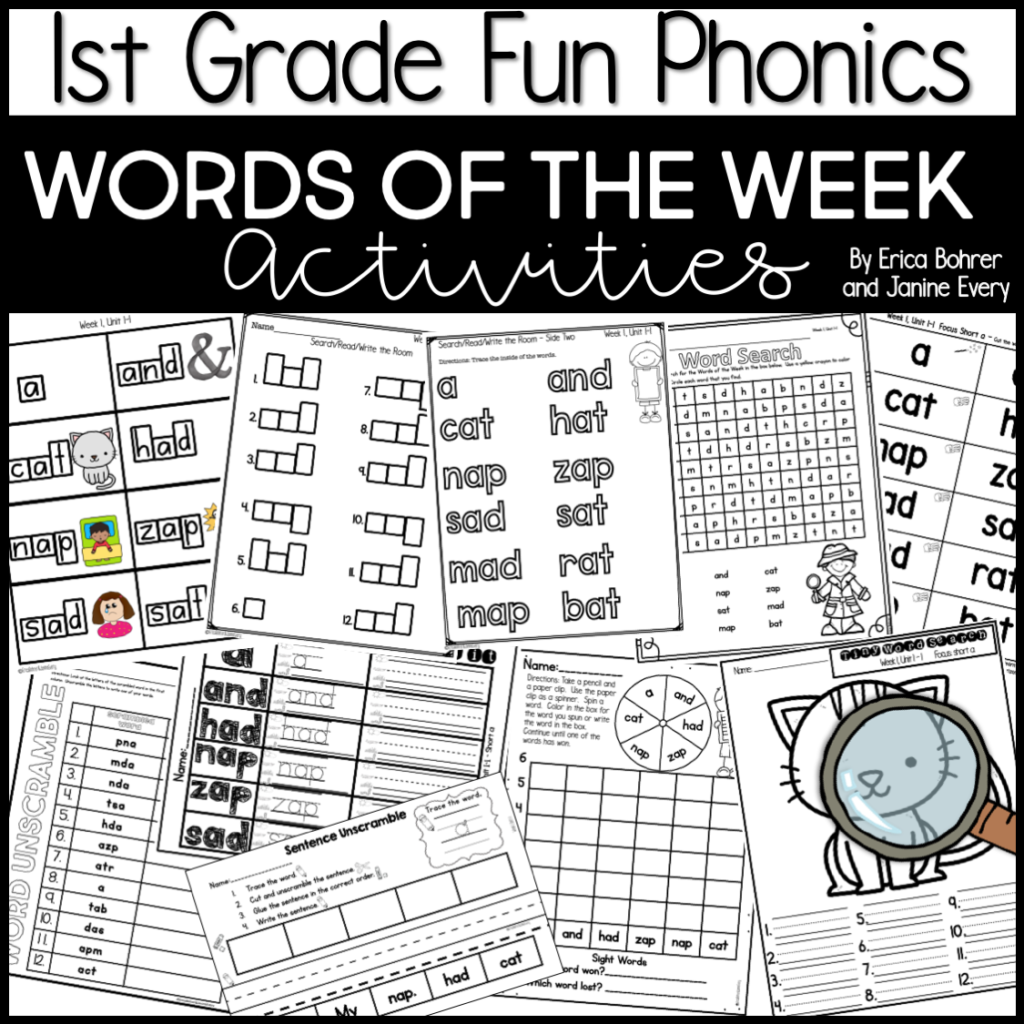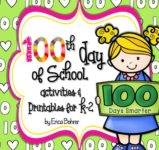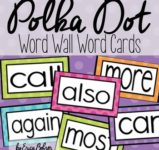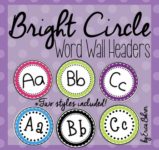By now most of us have heard of the Science of Reading. I am no way an expert, but what I do know is that systematic phonics instruction is needed for students to become strong readers. I have had quite a few questions about the phonics program that I use with my first grade students. I decided to write a blog post with links to all the resources I use and why I use them.
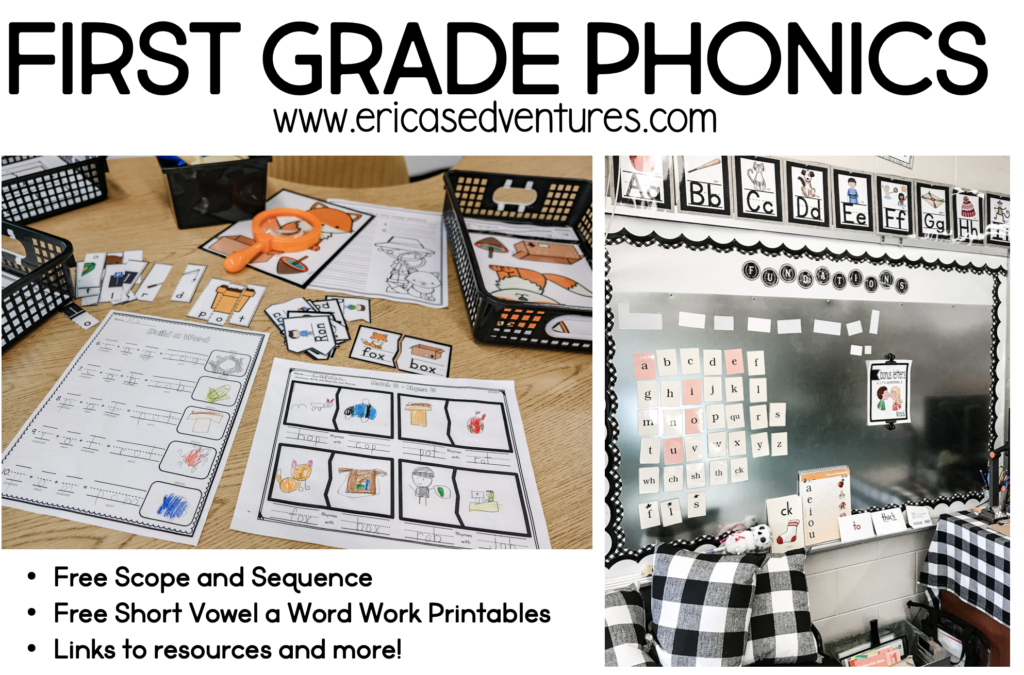
*This post contains some affiliate links. What this means, is that if you purchase an item through a link I have provided, I get a small commission at no additional cost to you. I do NOT get compensation for the the phonics program I have linked. The phonics program has not sponsored or approved of this post.
Phonics Program Overview
For the past few years, my district has supplemented a textbook based reading program with a systematic phonics curriculum which includes sight word/trick word instruction. You can read about the FUNDATIONS® phonics program on their website HERE. It is definitely not a program you could purchase individually, it would have to be a district decision to purchase the program. I was trained on the terminology utilized in this program, how to structure lessons, and on how to “mark up” words. It is an intense program but I highly recommend it! As with any purchased program, you the teacher, have to make it work for you. What I did notice since implementing this program was that my students became better spellers in their writing and they were better able to break apart and decode unknown words when reading. The program suggest you do lessons for 25 to 30 minutes a day but I find my lessons can take up to 40 minutes a day. The students don’t seem to mind because there is a lot of movement from desks, to the group sharing area, and there is also standing. There are also a variety of materials that are utilized like large and small magnetic tiles, student workbooks, and dry erase boards and markers. Each lesson is scripted but after a few years of doing the program, you will not need to have the manual open the whole time you are teaching. What I like is that the program works and that it provides mastery for all types of learners. My students would see a glued sound, a bonus letter, or a digraph in a word they were reading and get so excited to show me. I loved that!
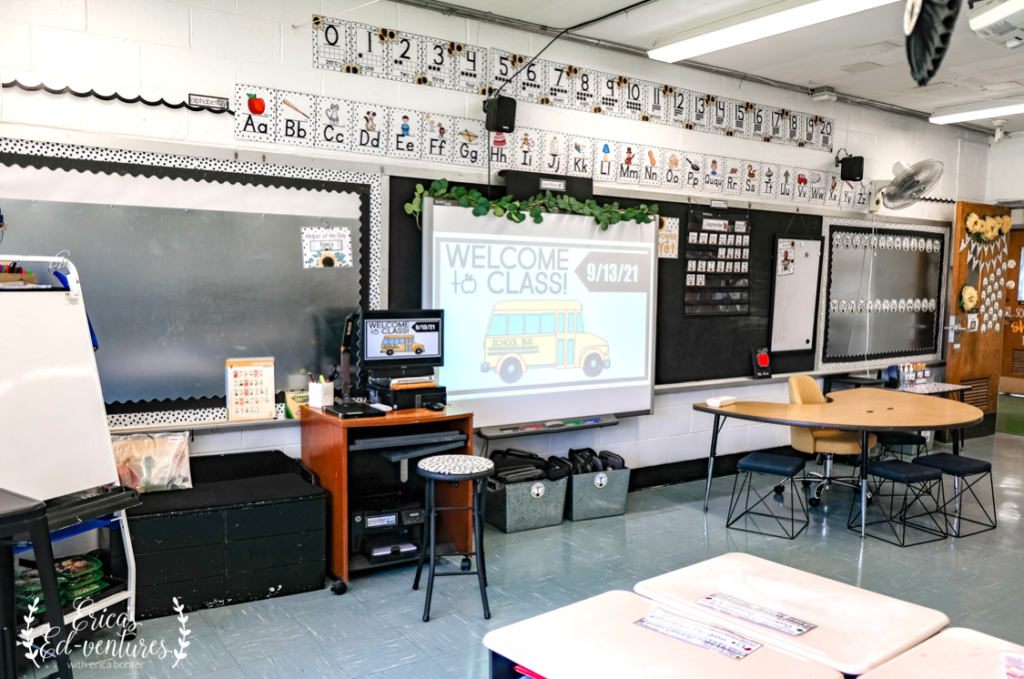
Here is a look at the front of my room where I facilitate my phonics lessons. I have two whole bulletin boards covered in sheet metal. *For more details on my current classroom set up, see this blog post. I use the board on the left for the standard sound cards (large magnetic tiles) or to temporarily display the large picture cards.
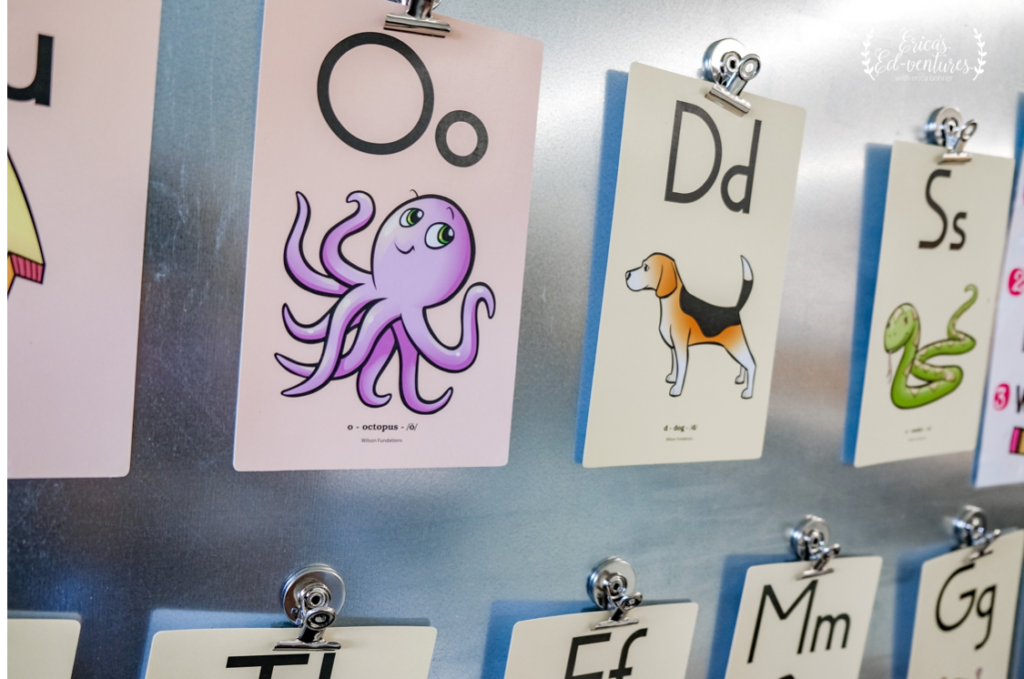
In Unit 1, Week 1, Day 5 there is a “Make it Fun Activity” where the students sky write a letter and the other other students have to guess which letter they are sky writing. The students have so much fun with this activity that I do it throughout Unit 1 and 2, whenever we have free time. I put the large cards up as a quick reference for the students using metal clips. *The program does not recommend keeping the Large Sound Cards up all the time.
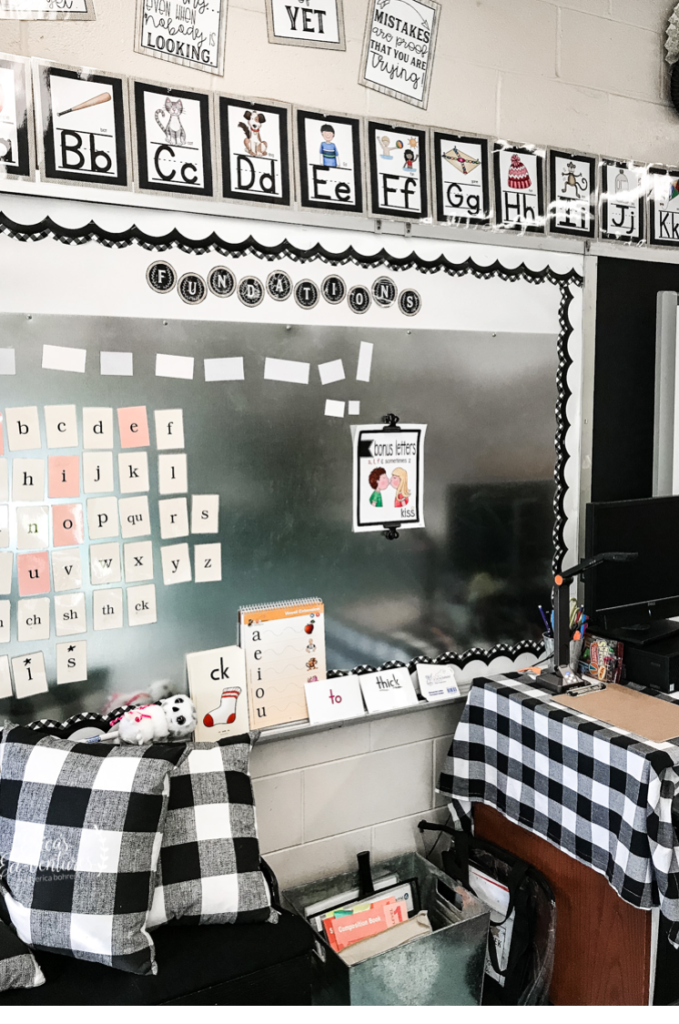
I use my own alphabet posters to match my classroom theme. You can search my alphabet posters which compliment the phonics program HERE. My newer resources have key pictures that compliment the phonics program, just check the descriptions before purchasing. I have also created phonics posters HERE – these have a variety of poster and many were customer requests which are not part of the FUNDATIONS® phonics program. For example, blends are not represented by a key word image in FUNDATIONS® but glued sounds such as -ank, -ink, -onk, -unk, ang, -ing, -ong, and -ung are.
Sight Words/Trick Words
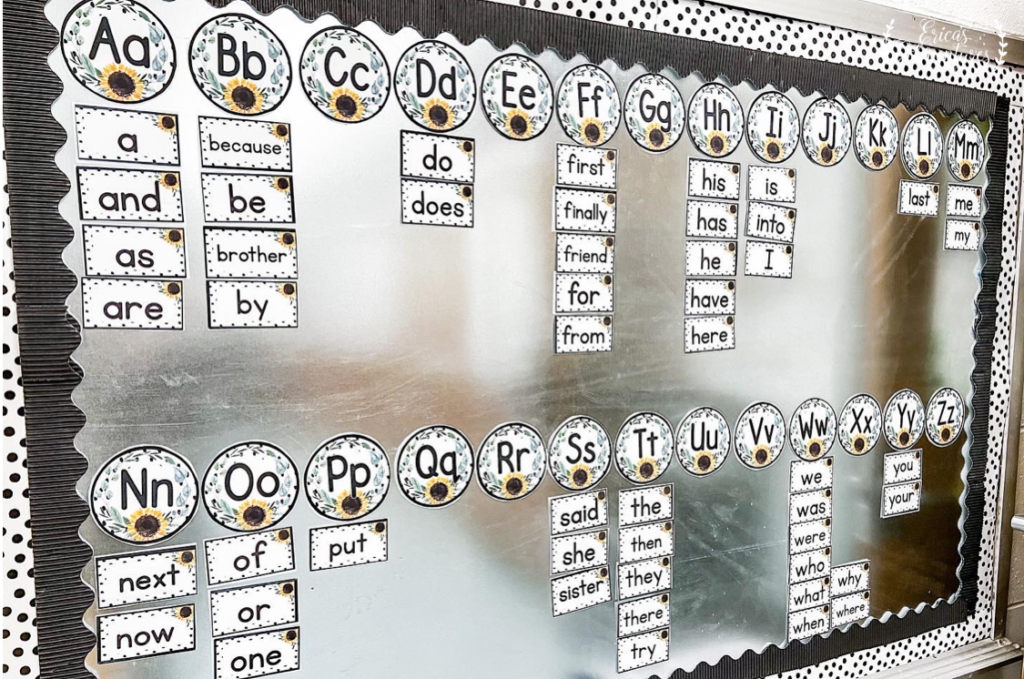
The board above is for my trick words/sight words. The phonics program I use does not suggest displaying these words but I find that my students like having them in the room and will go up and take a word off the wall during writing time. I add the sight words to the board as we learn them. The board below is my previous word wall. I did not use matte laminating sheets and you can see the glare compared to the sunflower word wall set above where I used matte laminating sheets. You can find the simple, black-lined word cards HERE. One thing I have changed over the years with how I teach sight words, is that I point out to the students the parts of the sight word that follow phonics rules and then I point out the parts that don’t and call them the “tricky parts.” I don’t call them “heart words” as they do in Science of Reading because I want to stick with the terminology of our phonics program and call them “trick words.”
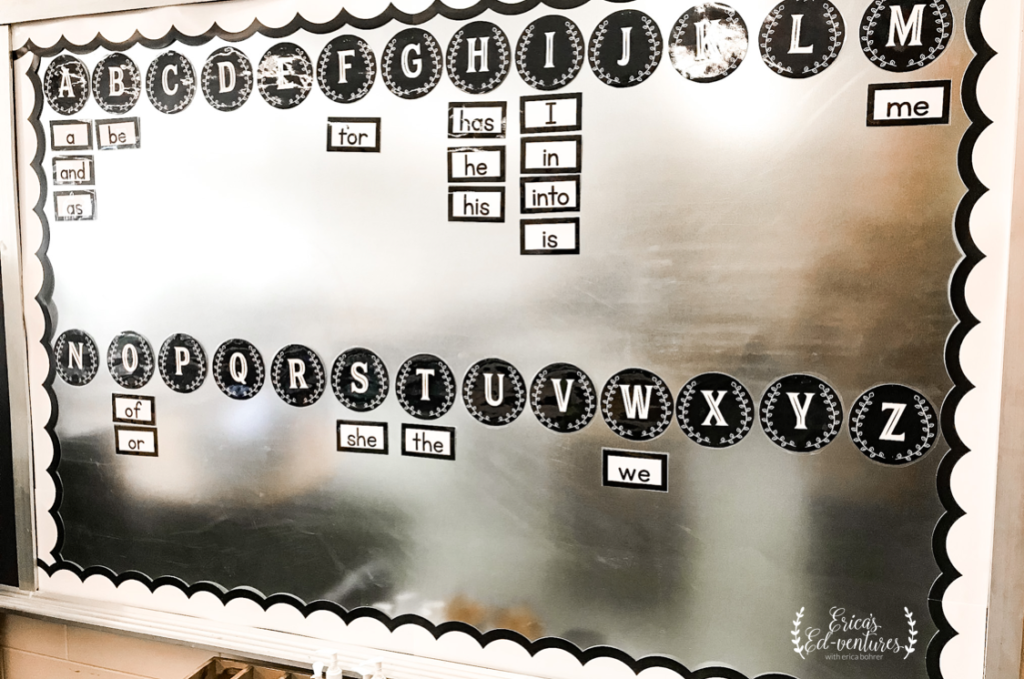
Lesson Planning
During Covid, I switched from having the students touch all of my materials to using a document camera and/or using Google Slides. I also made my trick word drills into digital videos. It was easier for my students who were remote to see the words and it freed up my hands to do other things. The slides also kept me on track with the lesson and made it so I did not have to refer to my manual as much. I have a free sample lesson below. As Covid restrictions have eased up, I am having students interact with my materials more.
Materials and Procedures
The program comes with thin fabric envelopes for the students’ supplies. I find that those do not last very long, so instead, I purchase these pouches from Amazon. I then label the pouches with numbers corresponding to the number of students I have in class. You can grab those labels for FREE HERE. I cover the labels with clear packing tape. I label all of the students’ phonics supplies with their number, I even number the backs of all their letter tiles. This makes it so much easier if one falls on the floor. Metallic Sharpies work well for labeling the back, dark side of the magnetic letter tiles.
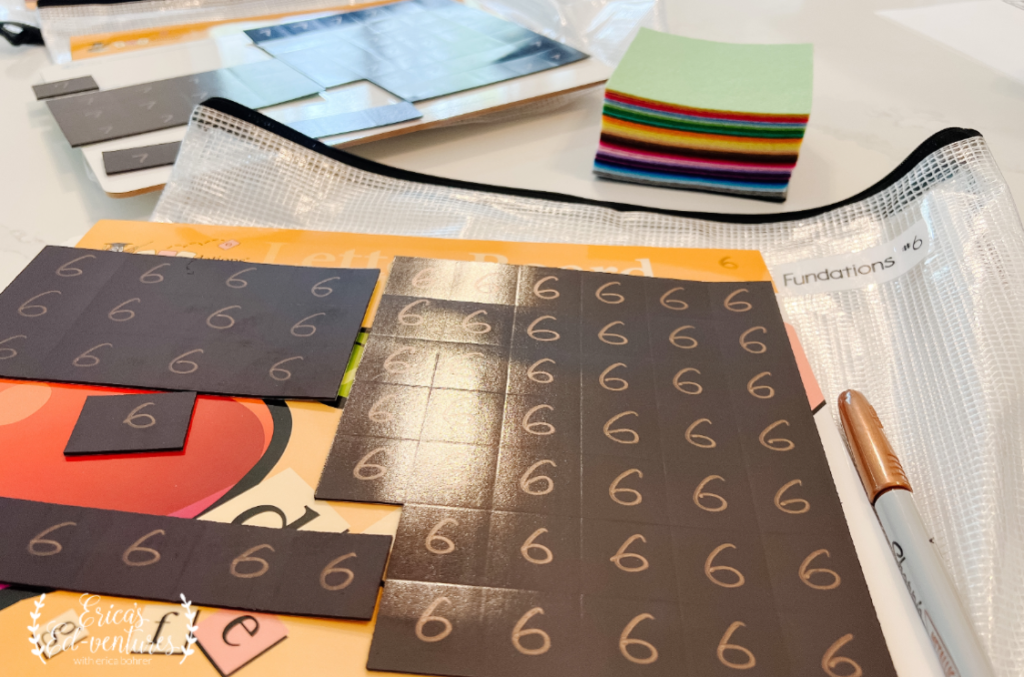
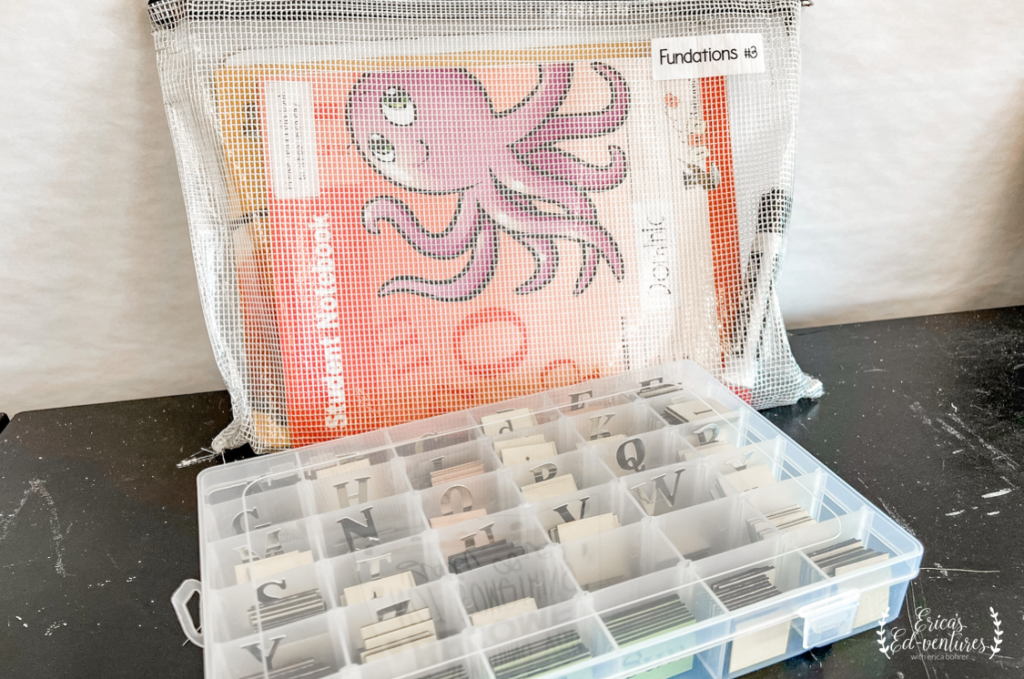
The plastic toolbox is for the extra letter tiles. It makes it so much easier to find extra tiles when they are sorted into individual compartments.
In the photo, you can see a larger Expo marker but I have found that those are a bit difficult for the students to mark up words with. The skinny dry erase Expo markers work are better for marking up words. Also, only by one color – black! This eliminates students from trading in markers to get a better color. I have the students use small felt squares as erasers – these might be good to purchase in different colors. Right now, I only have red pieces of felt and when they fall on the floor nobody claims them.
When having students decode words, I have all of them with the materials need on their desk and their envelopes with their other supplies on the floor leaning on their desk legs. I ask the students to put their hands behind their back so that they don’t start writing before tapping out words. Here is an example:
Teacher: “Hands behind your backs, eyes on me.”
Teacher: “I say, you say…ring”
Students: “ring”
Teacher: “Elbows up and tap out ring.”
Students: “r-ing”
Teacher: “Pick up your markers and spell the word ring and mark it up.”
Teacher walks around to monitor as students write the word.
Teacher: “Put the cap on your marker and put the marker on top of your eraser when you are done.”
Teacher asks a student to spell the word “ring” as she writes it on the dry erase board under the document camera or has the student come up and write the word and mark it up.
Teacher: “Erase your boards and get ready for the next word.”
After the lesson, I give my students an exit ticket. This quickly lets me know what I need to review for the following lesson. You can grab the exit tickets for unit one below for free.
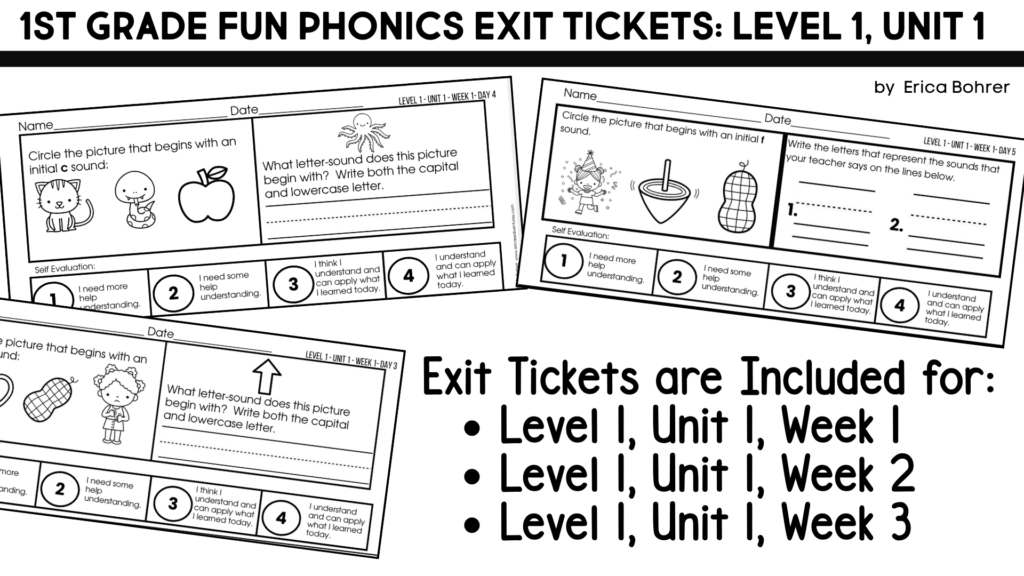
I have created exit tickets for each unit, you can grab them individually or as a bundle:
- Level 1, Unit 1 Exit Tickets
- Level 1, Unit 2 Exit Tickets
- Level 1, Unit 3 Exit Tickets
- Level 1, Unit 4 Exit Tickets
- Level 1, Unit 5 Exit Tickets
- Level 1, Unit 6 Exit Tickets
- Level 1, Unit 7 Exit Tickets
- Level 1, Unit 8 Exit Tickets
- Level 1, Unit 9 Exit Tickets
- Level 1, Unit 10 Exit Tickets
- Level 1, Unit 11 Exit Tickets
- Level 1, Unit 12 Exit Tickets
- Level 1, Unit 13 Exit Tickets
- Level 1, Unit 14 Exit Tickets
Independent Learning Activities
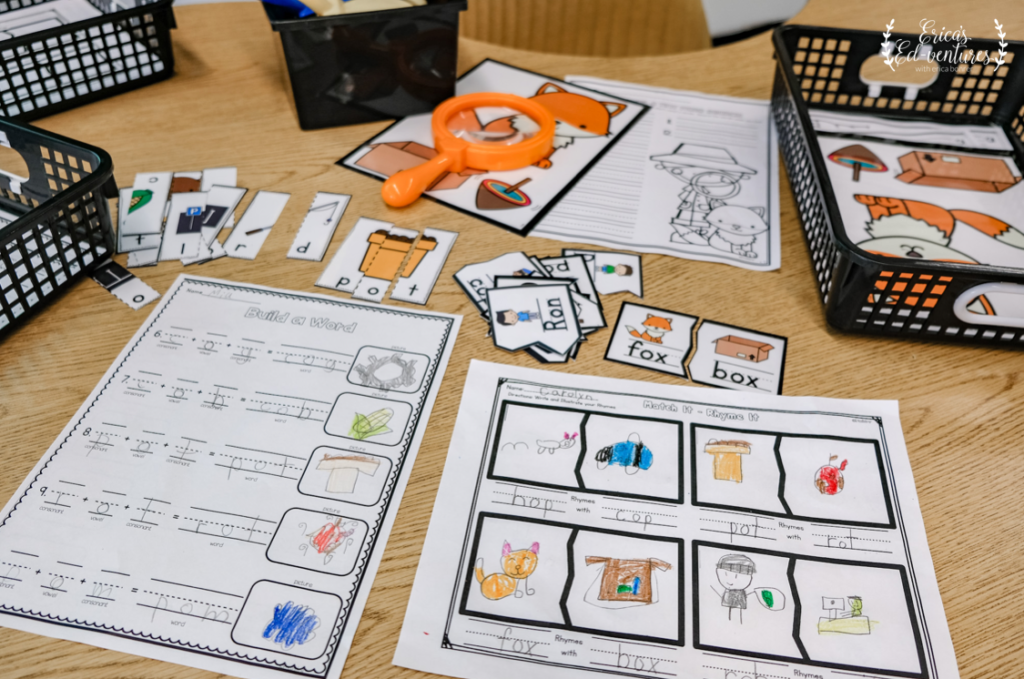
I have ELL and general education students in my classroom. I find that visuals help support my ELL learners and my struggling readers, so I created primary lined word work centers based around the phonic elements we study. The words are words the students can sound out/tap out and the pictures help to reinforce the meanings of the words. I find these centers to be a beneficial use of independent learning time. While the students are activity engaged at centers, I pull groups for guided reading. You can click on the center resource titles below for exactly what is included in each resource. The resources have the same activities with a different phonic skill focus each week. I model how to do the activities once or twice at the beginning of the school year. Then throughout the rest of the school year, the students are able to work independently at the centers, with little to no teacher support.
I created phonics based literacy center resources for nearly each week of the school year. I have a few more to add but I have them bundled HERE. You can grab them at a big discount by purchasing the bundle. Please follow my store to get emails alerts as to when I add the remaining phonics center resources or pin this post and check back. I will update the links in the scope and sequence list below. I decided to include some word work centers for vowel teams, r-controlled vowels, and diphthongs because I felt the students needed exposure to these words even though our phonics program does not expect students to know how to spell them. For some of those weeks, I have two center resource packets linked. I plan on mixing the centers from both resources or using one of the center resources for early finishers. I have posted a typical week of center plans below. My literacy center resources would work with any phonics program you use and would be suitable for first grade or kindergarten students.
Each resource contains the following primary lined centers and recording sheets:
- File Folder with Pictures
- Writing Center
- Search-Read-Write the Room
- Rhyming Activity
- Build a Word
- Word Sort
- Build a Sentence
- Tiny Word Search
- Roll & Write a Word
- Word Search
I introduce the students to centers with color centers on the first week of school.
Then we go into the phonics based centers. I have a sample of my phonics based literacy centers below in this short vowel review resource.
Phonics Based Literacy Centers Scope and Sequence:
- Unit 1, Week 1 – Short a
- Unit 1, Week 2 – Short e
- Unit 1, Week 3 – Short i
- Unit 2, Week 1 – Short o
- Unit 2, Week 2 – Short u
- Unit 3, Week 1 – Digraphs sh & wh
- Unit 3, Week 2 – Digraphs ch & ck
- Review – Digraph th
- Unit 4, Week 1 – Bonus Letters
- Unit 4, Week 2 – Glued Sound -all
- Unit 5, Week 1 – Glued Sounds -am & -an
- Unit 6, Week 1 – Suffix -s
- Unit 6, Week 2 – Suffix -s
- Unit 6, Week 3 – Suffix -s
- Unit 7, Week 1 – Glued Sounds ang, ing, ong, & ung
- Unit 7, Week 2 – Glued Sounds ank, ink, onk, & unk
- Unit 7, Week 3 – nk & ng words with Suffix s
- Unit 8, Week 1 – Initial Blends
- Unit 8, Week 2 – Final Blends
- Unit 9, Week 1 – R-Controlled Vowels
- Unit 9, Week 2 – Vowel Teams
- Unit 10, Week 1 – Words with Five Sounds and Diphthongs oi/oy, ew/oo/oo
- Unit 10, Week 2 – Words with Five Sounds and Suffix -s or Diphthongs ou/ow
- Unit 10, Week 3 – Suffixes -ed & -ing
- Unit 11, Week 1 – VCE
- Unit 11, Week 2 – VCE
- Unit 11, Week 3 – VCE with Suffix -s
- Unit 12, Week 1 – Multisyllabic Words with Two Closed Syllables
- Unit 12, Week 2 – Multisyllabic Words with One Closed and One VCE Syllable
- Unit 12, Week 3 – Multisyllabic Words
- Unit 13, Week 1 – Multisyllabic Words with Suffix -s, -ed, and -ing
- Unit 13, Week 2 – Suffix -es
- Unit 13, Week 3 – Suffix -es
- Unit 14, Week 1 – Review of Concepts
- Unit 14, Week 2 – Review of Concepts
You can grab all the above centers at a deep discount by purchasing them bundled and linked below.
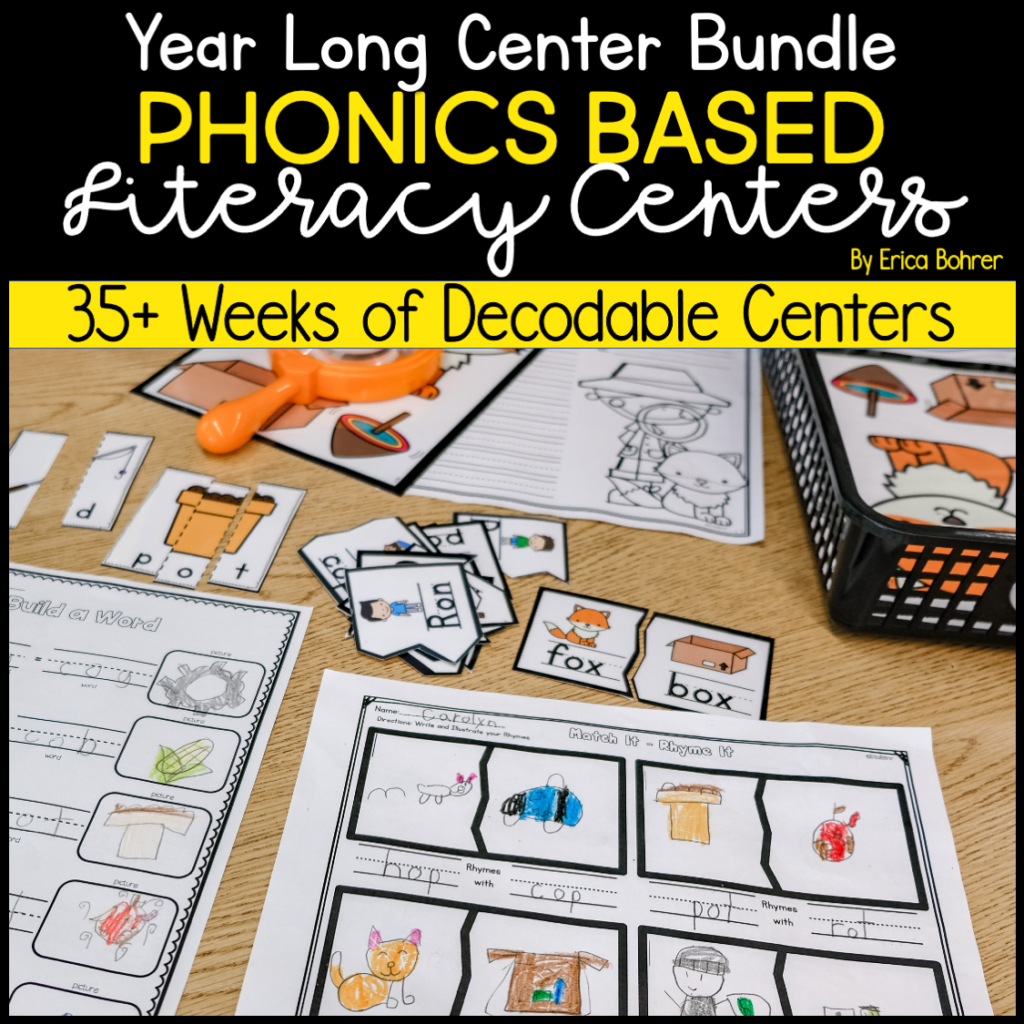
I store the centers in those same zip pouches I use for the students Fundations supplies:
For morning work, early finishers, and extra centers, my colleague Janine and I created a low prep resource called First Grade Fun Phonics Words of the Week Activities. Download the preview file to get a week’s worth of short a printables for FREE.
Each week includes the following printable activities:
- Word List of 12 words
- Search Read Write the Room Activity – Students search the room for word cards and record the words they find in the boxes on the recording sheet. *We have also included you with alternative lined recording sheets that can be used with the word list word cards. These can be found in the “extras” section of the resource.
- Tiny Word Search Activity – Students use a magnifying glass to find the tiny words and record them.
- Say it – Trace it- Write it – Students say the word, trace the word, and then write the word. They can also mark up the words when they are done.
- Spin and Graph a Word – Students use a paper clip to spin and land on a word. Then they graph the word they spun. They continue until they have a word that “wins.”
- Word Unscramble – Students unscramble words and record them.
- Word Search – Students search for the words of the week in a word search.
- Sentence Unscramble (in almost each week, this is based on the “trick words”)
Below you can see a page from my plan book which shows a typical week of literacy centers in my classroom. I set a timer for 27 minutes for each center rotation. At the end of the two center rotations the students share their work and self-evaluate to earn Dojo points. *I have an older blog post about Literacy Center Set Up HERE.
Here is how I display the rotations, you can grab them for free below:
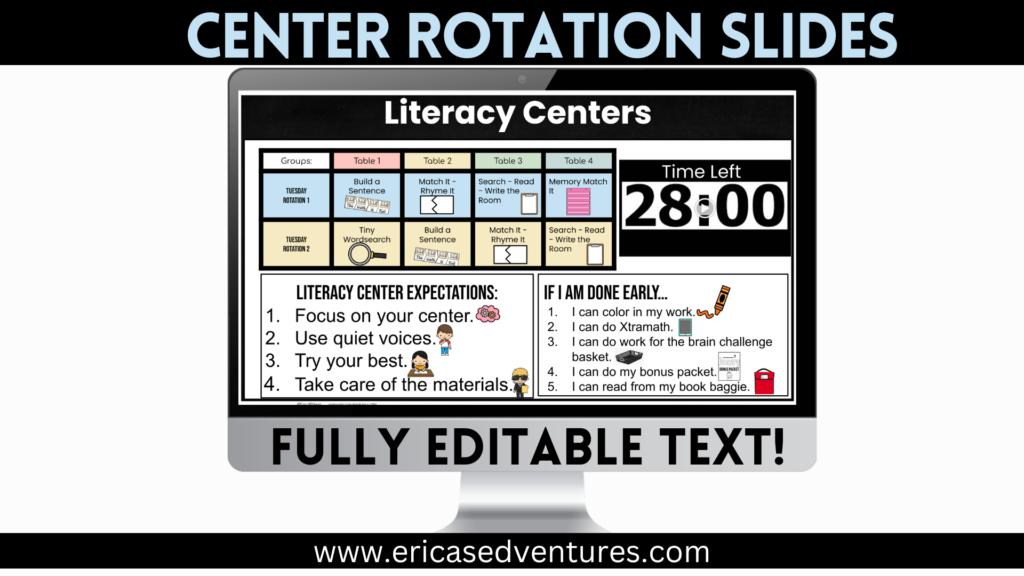
While doing guided reading lessons, I reinforce the decoding strategies taught during our phonics lessons using these posters.
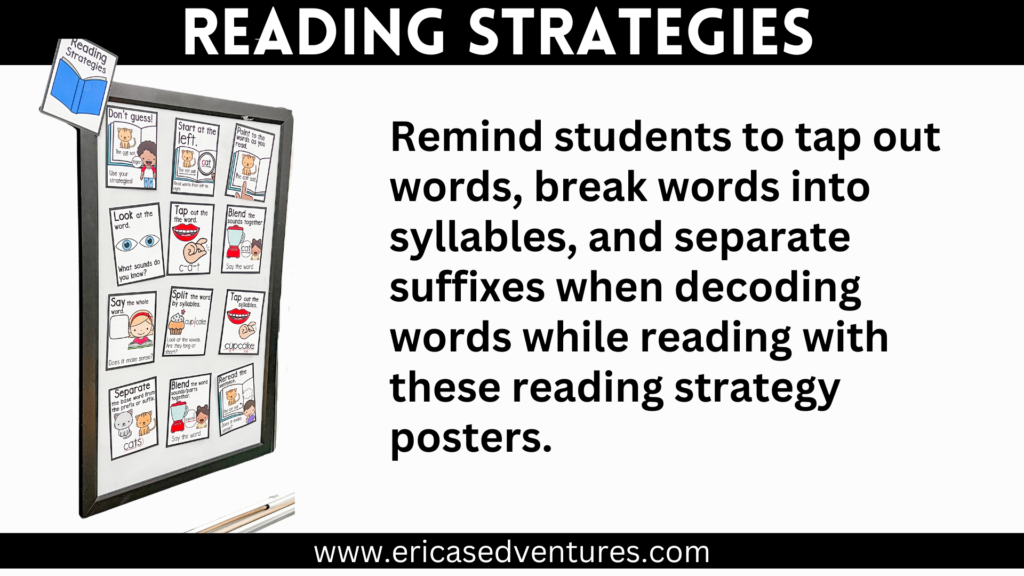
My students LOVE center time and they enjoy our phonics lessons. They thrive on the consistency and structure of our daily phonics lessons and literacy center rotations. I firmly believe in creating a strong phonics base in kindergarten and first grade. I hope that this post helped you to fid some new ideas and resources!
I sell additional “fun” foundational phonics resources HERE.
All resources mentioned can be used to enhance your work with the FUNDATIONS® and WILSON READING SYSTEM®. Please note, you do not need the programs to utilize these resources with your students.
This post is an independent post and is not affiliated with, nor has it been authorized, sponsored, or otherwise approved by Wilson Language Training Corporation. WILSON®, Wilson Reading System®, Fundations®, Just Words®, and Wilson Fluency® are trademarks and/or registered trademarks of the Wilson Language Training Corporation.
Pinterest Image:
